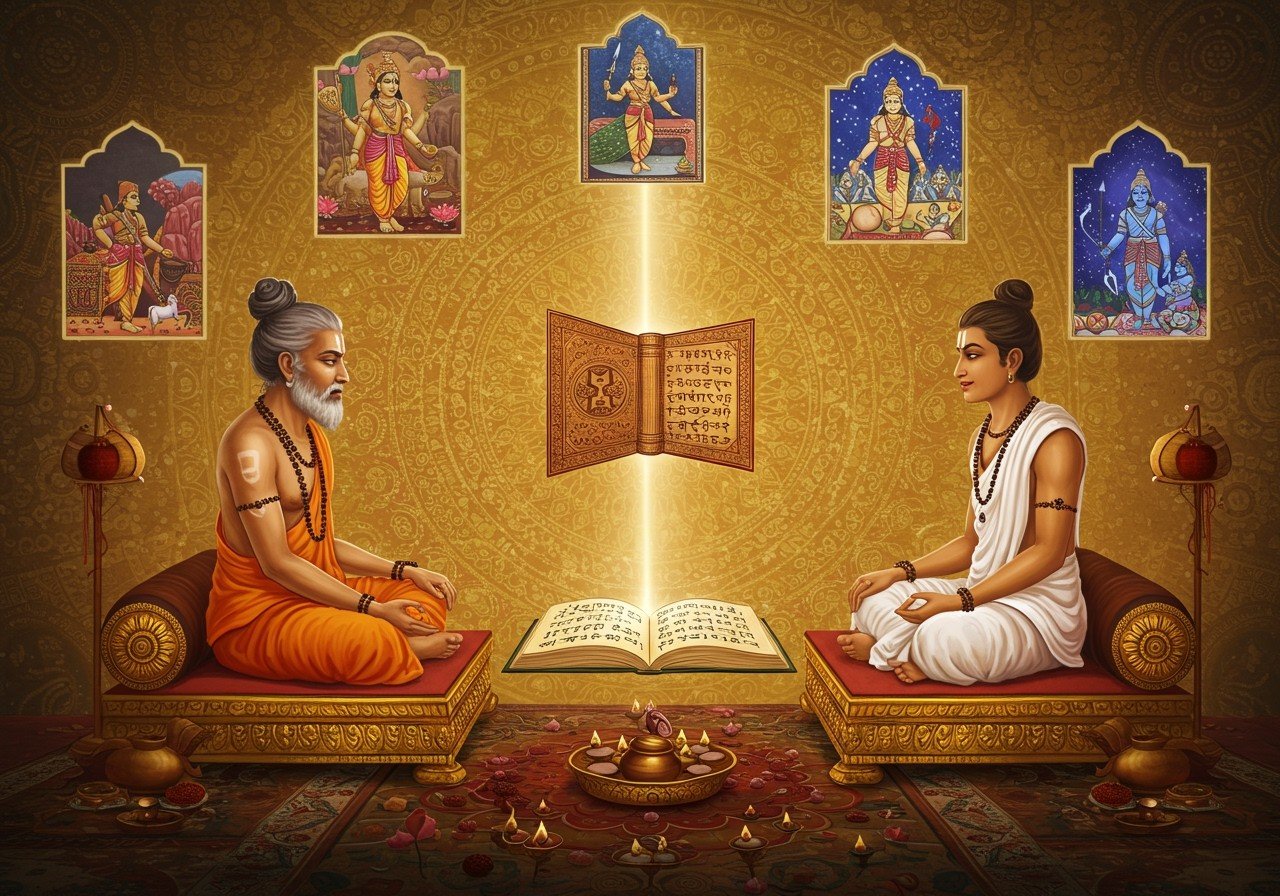
The Mahabharata, a cornerstone of Indian culture and tradition, is traditionally attributed to Vyasa. This epic narrative holds immense cultural significance, offering profound lessons and stories. However, another version exists, known as the Jaimini Mahabharata or Jaimini Bharata, providing a unique lens through which to explore these ancient tales. Understanding different versions like Jaimini Bharata deepens our appreciation for the diverse interpretations of these cultural narratives. Poojn.in, India’s leading store for cultural goods and services, offers a variety of resources to support your exploration of this rich tradition.
What Distinguishes Jaimini Bharata?
Jaimini Bharata offers a distinct retelling of the Mahabharata, focusing primarily on the Ashvamedha Parva, the horse sacrifice ceremony. This version delves deeper into ethical dilemmas and philosophical discussions, presenting a different perspective compared to Vyasa’s narrative. The structure of Jaimini Bharata highlights core themes such as dharma (righteousness) and karma (action), offering valuable insights into Indian philosophy.
The Ashvamedha Yagna, a significant ritual in ancient India, plays a central role in this version. Jaimini’s portrayal emphasizes its cultural and traditional importance, making Jaimini Bharata a valuable resource for those interested in exploring Indian rituals and philosophy. This focus on rituals and ethics offers a unique opportunity to engage with the Mahabharata through new themes and ideas.
The Authorship of Jaimini Bharata
Jaimini, a disciple of Vyasa, is traditionally credited with authoring Jaimini Bharata. His version focuses on specific episodes, particularly the Ashvamedha Parva. While scholarly debate continues regarding the exact authorship, Jaimini remains widely recognized for his contributions. His background in Mimamsa, a school of Hindu philosophy, likely influenced his unique rendition of the Mahabharata. Some scholars suggest multiple contributors to Jaimini’s work over time. Despite the ongoing discussions, Jaimini Bharata remains a significant piece of Indian literature. This version offers a unique lens through which to understand the complexities of ancient Indian thought.
Key Differences Between Jaimini’s and Vyasa’s Epics
Jaimini Bharata offers several key distinctions from Vyasa’s Mahabharata. Jaimini’s focus on Yudhishthira’s Ashvamedha Yagna emphasizes the reconstruction of peace and the reconciliation among characters, particularly the children of Karna, offering a different perspective on the aftermath of the war. The emphasis on rebuilding relationships adds a new dimension to the traditional narrative.
- Scope and Length: Jaimini Bharata, comprising 68 chapters and 5147 verses, is longer than Vyasa’s Ashvamedhikaparva (133 chapters and 3320 verses). Jaimini’s narrative centers almost entirely on the Ashvamedha yajna, providing in-depth exploration of this ritual. This concentrated focus allows for a more detailed examination of the yagna’s significance.
- Narrative Variations: Differences extend to specific narratives as well. Yudhishthira’s lament after Bhishma’s funeral unfolds differently in Jaimini’s version, as does Arjuna’s interaction with Ulupi and Chitrangada. These variations offer a fresh perspective on familiar stories, encouraging deeper reflection on the characters’ motivations and actions. The inclusion of characters like Vrisaketu and Meghavarna adds another layer of complexity to the narrative.
Cultural and Philosophical Significance
Jaimini Bharata holds significant cultural and philosophical weight within Indian tradition. The emphasis on ritual and ethics enhances the diverse narratives present within the broader Mahabharata tradition. Jaimini’s work provides a valuable resource for understanding Indian culture, religious practices, and the ongoing relevance of ancient texts in contemporary discourse. By exploring different themes and narratives, Jaimini’s work enriches the study of Indian culture and philosophy. The focus on Krishna’s worship as an avatar of Vishnu further highlights the spiritual dimensions of the narrative.
The availability of vernacular versions underscores its wider impact across different regions, contributing to a richer understanding of India’s cultural heritage. Preserving and studying both Vyasa’s and Jaimini’s versions offers deeper insights into these ancient texts and their enduring significance in modern times. Explore our collection of Mahabharata texts and related resources at Poojn.in to deepen your understanding of these epic narratives.
Connecting with Jaimini’s Mahabharata through Poojn.in
Poojn.in provides a wide selection of products that can enhance your study and appreciation of Jaimini’s Mahabharata. From sacred texts and ritual items to handcrafted accessories, we offer everything you need to connect with this rich tradition.
Explore these relevant offerings on Poojn.in:
- Srimad Bhagavad Gita (Bengali Version): Delve deeper into the philosophical teachings within the Mahabharata.
- Clay Doat for Saraswati Puja: Honor the goddess of knowledge and wisdom as you engage with sacred texts.
- Barley (Jab): A traditional offering for rituals and ceremonies.
Visit Poojn.in or call us at 3369029784 for convenient doorstep delivery across India. Our products are carefully packaged to preserve their ritual purity and come with authenticity certification. Note: Availability and prices are subject to change. Please visit our website for the latest information.
Embracing the Richness of Jaimini’s Mahabharata
Jaimini’s Mahabharata invites us to delve into an alternate perspective within India’s epic traditions. By focusing on the Ashvamedha Yagna and offering distinct narratives, it enhances our understanding of the Mahabharata. Jaimini’s emphasis on reconciliation, unique character portrayals, and rich philosophical insights provides a deeper appreciation for these timeless stories. This version reframes the Mahabharata not solely as a narrative of conflict but also as a reflection on peace and moral values. As we explore these narratives, we connect with the wisdom of the past, allowing these ancient stories to inspire and guide us in the present.
For a comparative study, refer to Ramayana and Mahabharata: A Comparative Study of the Epics. We encourage you to explore the rich resources available at Poojn.in to further your understanding of this captivating epic.
Frequently Asked Questions about Jaimini’s Mahabharata
What defines Jaimini Bharata? Jaimini Bharata is an ancient text that presents an alternate view of the Mahabharata, focusing on the Ashvamedha Yagna and offering unique insights into specific events and characters.
Who is the author of Jaimini Bharata? Sage Jaimini, a disciple of Vyasa, is credited with writing Jaimini Bharata, a narrative that differs from Vyasa’s more widely known version.
What are the key differences between Jaimini’s and Vyasa’s versions? Jaimini’s version emphasizes the Ashvamedha Yagna and offers more details on specific events and characters, providing a fresh perspective compared to Vyasa’s epic. The narrative structure and philosophical focus also vary between the two versions.
Is Jaimini Bharata considered authentic? Yes, within Indian tradition, Jaimini Bharata is regarded as an authentic text, valued for its unique perspective on the Mahabharata.
Why did Jaimini write his version? Jaimini’s version provides a different lens on the events of the Mahabharata, focusing more on spiritual and ritualistic elements, such as the Ashvamedha Yagna, which adds depth to the narrative’s meaning.
Does Jaimini’s Mahabharata encompass the entire story? No, it concentrates primarily on the Ashvamedha Yagna, offering a detailed exploration of this specific event rather than covering the entire Mahabharata narrative.
Explore more about Indian rituals and traditions at Durga Puja Celebration: Rituals, Recipes, and Regional Differences and discover the divine feminine at Maa Lankeswari Temple: Exploring the Divine Feminine in Odisha.


